The beautiful state of Wisconsin is home to 16 million acres of forest land. 46 percent of the land area in Wisconsin is trees! In the northern part of the state, you will find maples, aspen, northern red oak, basswood, and pine. In the south, you can see mostly oak, maple, and basswood. Wisconsin supports a healthy forest ecosystem, produces wood products, and provides a home to many creatures that thrive in their lush forests.
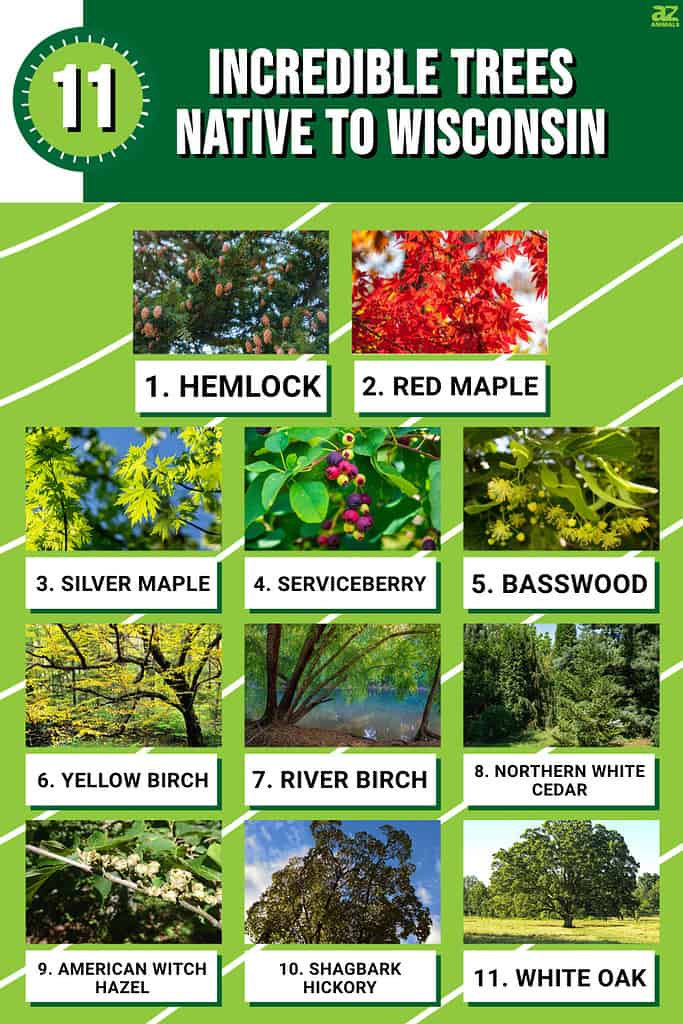
1. Hemlock (Tsuga canadensis)
Hemlock is a native evergreen tree found in Wisconsin. It has dark green needles which are soft to the touch and grow in flattened sprays. The bark of hemlock is gray-brown and scaly, with small furrows that become more prominent on older trees. Hemlock prefers moist soil and humid climates such as those found in Wisconsin’s forests and swamps, growing up to 100 feet tall.
This species provides food for many animals, including white-tailed deer, grouse, porcupines, beavers, woodpeckers, chipmunks, and squirrels who eat its buds or cones. Hemlocks also provide excellent cover for wildlife due to their dense canopy of foliage; they are important components of the state’s ecosystem!
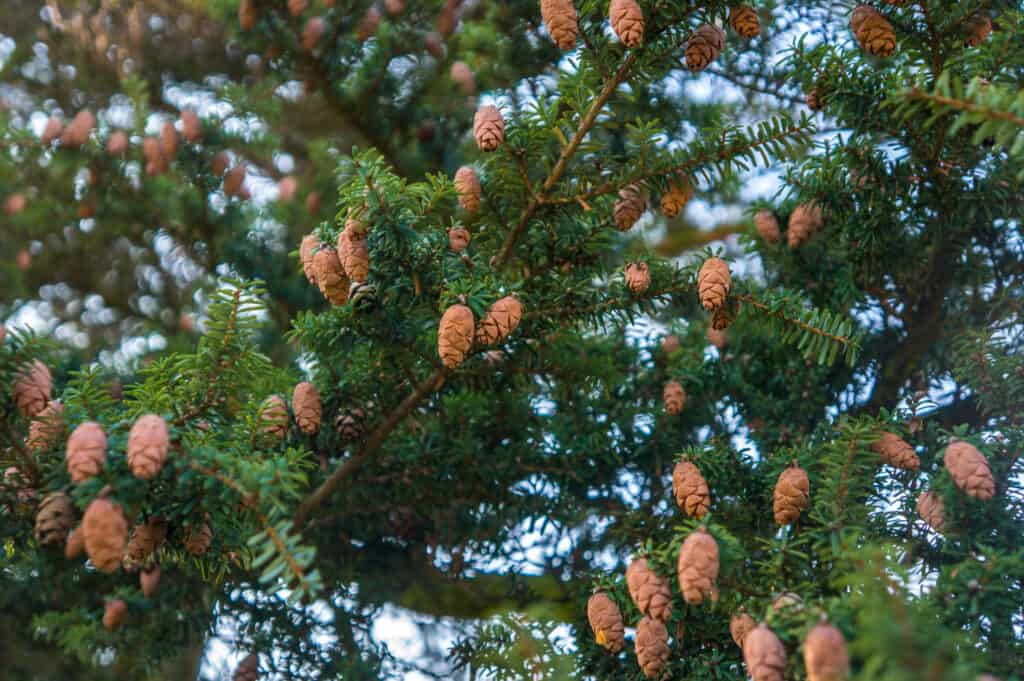
Hemlock trees can endure heavy snowfall and even ice storms. It makes sense, then, that hemlock is a native tree in Wisconsin.
©iStock.com/Sara Lissaker
2. Red Maple (Acer rubrum)
Red maple is a deciduous tree native to Wisconsin. It is a medium-sized tree, typically growing between 40 and 70 feet high, with a rounded crown and a trunk that can reach one to three feet in diameter. The bark is grayish-brown and smooth when the tree is young. As it ages, the bark grows darker and cracks into long plates. In the fall, the leaves turn red, orange, or yellow.
The red maple tree provides essential wildlife benefits. It produces seeds eaten by squirrels, chipmunks, rabbits, deer, and other mammal species. The red maple also produces nectar for bees and butterflies and provides bird shelter in its thick foliage.
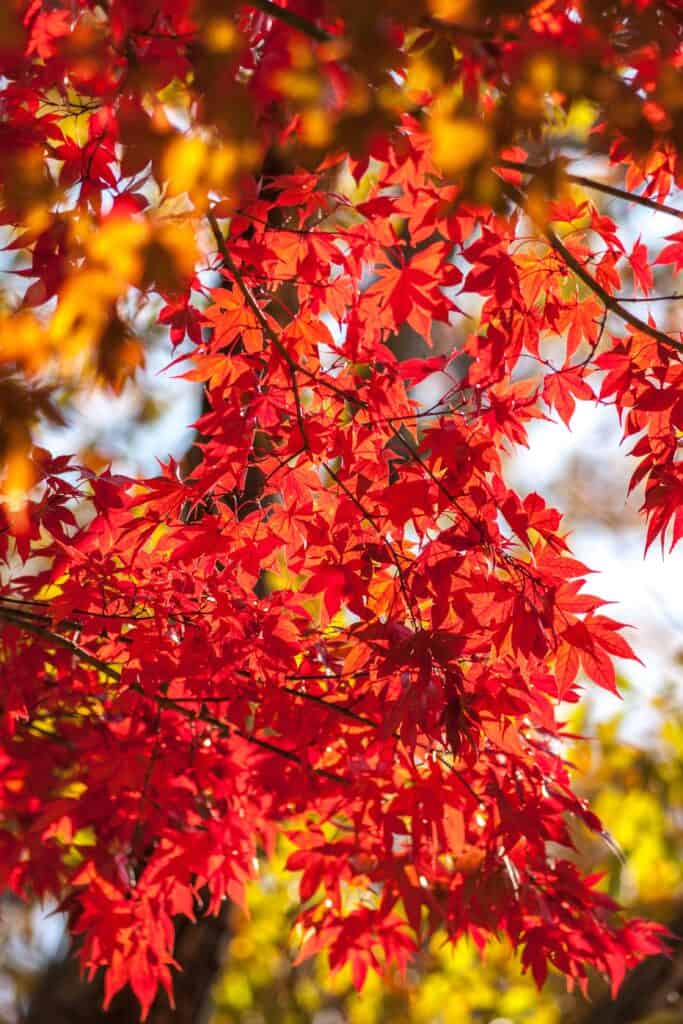
The red maple tree is a common deciduous tree in North America that usually grows up to 100 feet tall.
©Pvince73/Shutterstock.com
3. Silver Maple (Acer saccharinum)
Silver maple is a deciduous tree native to Wisconsin. It is a large tree, typically growing between 60 and 80 feet high, with a rounded crown and a trunk that can reach 2 to 3 feet in diameter. The bark is grayish-brown and shaggy after the tree matures. In the fall, the leaves turn yellow.
The silver maple tree provides many benefits for the local wildlife. Its large canopy of leaves creates plenty of shade during the hot summer months and helps keep temperatures cool. It can also provide shelter from wind, rain, and snow. The sap produced by this tree is an important food source for a variety of animals, including squirrels, birds, raccoons, deer, and even bears.
Additionally, its seeds are eaten by various small mammals, such as chipmunks, while larger birds, like woodpeckers, enjoy pecking away at dead branches for insects hidden beneath them. With its unique characteristics providing valuable resources to so many different types of wildlife species, it’s no wonder why the silver maple has become one of Wisconsin’s most beloved native trees!
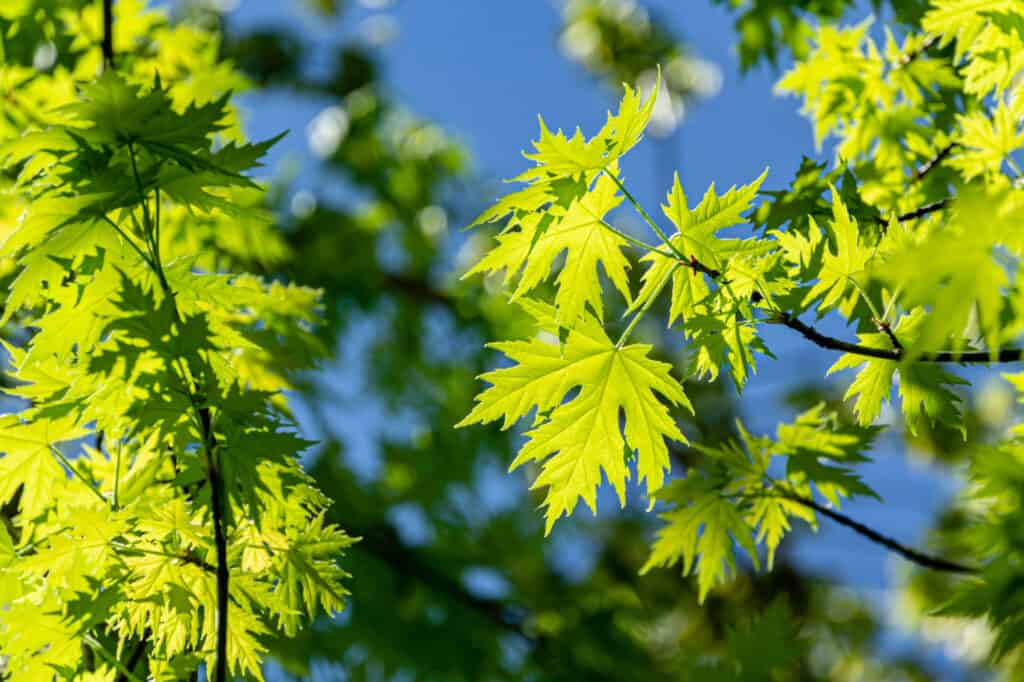
One of the most common trees in the U.S., silver maples have smooth, gray bark.
©Marinodenisenko/Shutterstock.com
4. Serviceberry (Amelanchier arborea)
Serviceberry is a deciduous tree native to Wisconsin. It is a small tree, typically growing between 16 and 39 feet high, with a rounded crown and a trunk reaching one foot in diameter. The bark is gray and smooth. In the spring, the tree produces white flowers, and in the summer, it produces small, dark purple fruits.
Animals like birds and small mammals like deer benefit greatly from the serviceberry tree. The tree produces edible berries that these animals can feed on during the summer when other food sources are scarce. Over 40 types of birds eat the ripe fruits of the serviceberry. Squirrels, rabbits, chipmunks, mice, foxes, deer, and bears love to snack on them too!
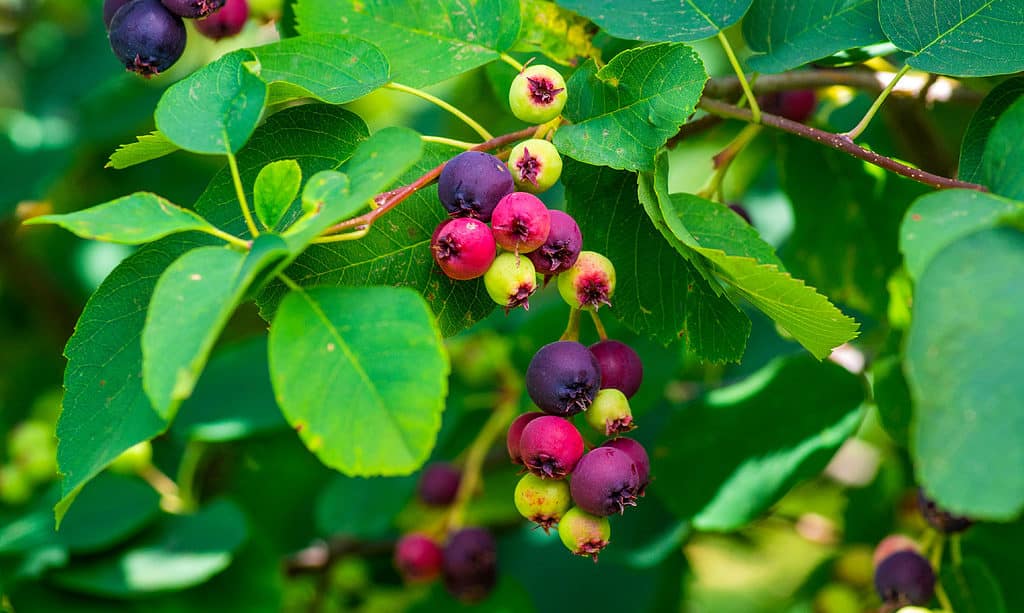
The western serviceberry is also called Saskatoon berry, western shadbush, and even western juneberry.
©Iva Vagnerova/Shutterstock.com
5. Basswood (Tilia americana)
Basswood is a species of tree native to Wisconsin and the Northeastern region of the United States. It is a deciduous hardwood tree that grows up to 60-120 feet tall, with a trunk diameter of up to five feet. The bark on basswood trees is grayish-brown in color, becoming more fissured with age. Its leaves are dark green in summer and turn yellow in fall before dropping off for winter dormancy. Basswoods produce fragrant creamy white flowers during early summer, which develop into small nutlets containing seeds.
Basswood is a great tree for wildlife and animals. Its large leaves provide shelter from the sun in summer, its fragrant flowers attract pollinators such as bees and butterflies, and its nut-like fruits are a major food source for many species of birds. Additionally, basswood trees provide a habitat for small mammals such as squirrels to nest in. These features make them an essential part of a healthy ecosystem!

Basswood is a flowering tree that’s native to Wisconsin.
©Alina Vaska/Shutterstock.com
6. Yellow Birch (Betula alleghaniensis)
Yellow birch is a deciduous tree native to Wisconsin. It is a large tree, typically between 60 and 80 feet high, with a rounded crown and a trunk that can reach three feet in diameter. The bark is yellowish and has a papery texture and a shiny appearance. As the tree matures, the bark flakes and peels in horizontal strips. In the fall, the leaves turn bright yellow.
Yellow birch is an important species for many animals. It provides food for numerous species of birds, such as chickadees, nuthatches, and woodpeckers, who feed on its seeds. Squirrels, rabbits, and deer eat their buds throughout winter. Even bears depend on yellow birch for their diet; they often feed on the sweet sap from its bark or eat birch nuts that have fallen below it. The tree also offers shelter in dense forests where it grows; chipmunks, mice, voles, and even songbirds make nests inside them to protect themselves from predators or harsh weather conditions.
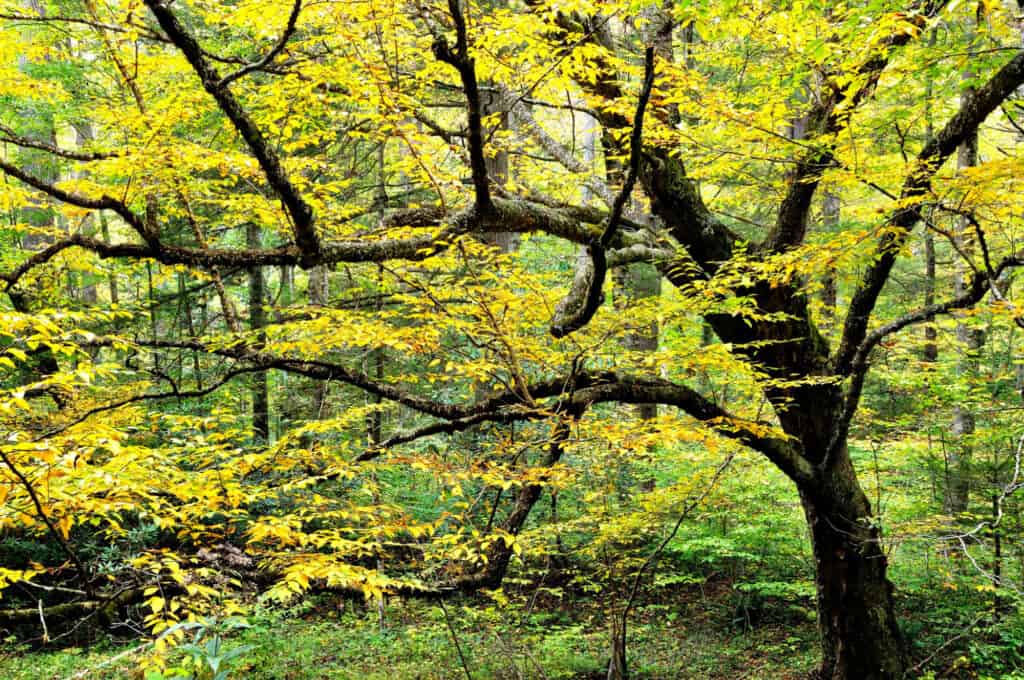
One of the most common birch trees used in the timber industry, yellow birches thrive in cooler climates.
©Malachi Jacobs/Shutterstock.com
7. River Birch (Betula nigra)
River birch is a deciduous tree native to Wisconsin, found only in the southwestern part of the state at low elevations. It is a medium-sized tree, typically growing between 80 and 100 feet high, with a rounded crown and a trunk that can reach five feet in diameter. When the tree is young, the bark is pink. As it matures, it turns a reddish-brown and starts scaling in loose curls and plates. In the fall, the leaves turn yellow.
River birch trees provide many benefits for wildlife. They offer food in the form of catkins and seeds, with their nuts being a particular favorite among birds and small mammals. Caterpillars, deer, rabbits, and other animals also eat the leaves. River birches also act as important shelters for many species of birds and mammals, and their dense foliage provides excellent cover from predators.
During winter months, the tree’s bark can be used to provide insulation against cold temperatures by some large mammal species. In addition, they are known to be home to various insects that serve as an additional food source for birds and small mammals alike. All these factors make river birches incredibly valuable components in Wisconsin’s ecosystem!

Also known as black birches, river birch trees thrive in wet conditions.
©Gerry Bishop/Shutterstock.com
8. Northern White Cedar (Thuja occidentalis)
Northern white cedar is an evergreen tree native to Wisconsin and other parts of North America. The trees have an elegant shape with a conical top and wide-spreading branches that give them a pyramidal form when young. It grows up to 50 feet tall and can live for hundreds of years if left undisturbed. Its bark is red-brown in color and furrows and peels with age. It has fan-like branches and leaves that look like scales. It produces yellow-green seed cones.
The northern white cedar is an incredibly beneficial tree to Wisconsin’s animal and wildlife populations. It provides shelter, shade, and food for many birds and mammals. Its foliage serves as a safe hideout for small animals like chipmunks and squirrels, while its branches provide nesting spots for various birds.

Northern white cedar is an evergreen that is native to Wisconsin.
©Alexander Denisenko/Shutterstock.com
9. American Witch Hazel (Hamamelis virginiana)
American witch hazel is a deciduous tree or small shrub native to Wisconsin. It typically grows between 15 and 25 feet high, with a rounded crown. The bark is brown and smooth, while the inner bark is reddish-purple. In the fall, the leaves turn yellow. This tree produces fragrant yellow flowers.
The American witch hazel tree is important to Wisconsin’s wildlife habitat. This small tree provides food and shelter for various species, including songbirds, ruffed grouse, turkey, and fox squirrels. The flowers provide nectar for pollinators like moths and butterflies.
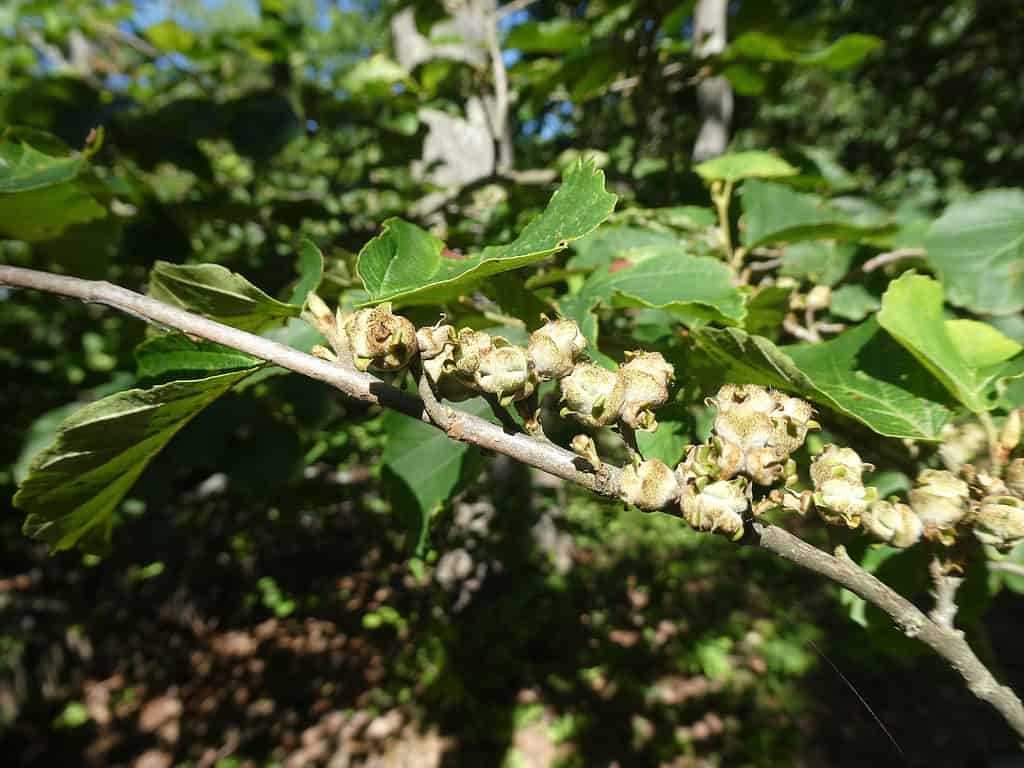
American Witch Hazel is a small shrub that is native to Wisconsin.
©ForestSeasons/Shutterstock.com
10. Shagbark Hickory (Carya ovata)
Shagbark Hickory is a tall, deciduous tree native to Wisconsin and other parts of the Midwest. It typically grows between 60 and 100 feet tall with a spread up to 45 feet wide. Its bark can be easily identified by its long, shaggy plates that hang down from the trunk in an uneven pattern.
The nuts produced by this species are edible and are popular with both humans and animals. In modern times, shagbark hickory has become popular for landscaping due to its stunning foliage displays throughout all four seasons of the year and its ability to thrive even when exposed to harsh winter weather conditions common throughout Wisconsin.
The shagbark hickory tree is a valuable part of Wisconsin’s native biodiversity. This hardy tree provides year-round benefits to many species of birds, insects, and mammals living in the area. Songbirds such as woodpeckers, nuthatches, and warblers feast on its nut-filled fruits. Insects such as butterflies find food sources in the leaves and bark of this tree, while small mammals like squirrels benefit from its production of nuts that provide sustenance through winter months when other food sources are scarce. The shagbark hickory is an important resource for many animals living in Wisconsin!

Shagbark hickory (Carya ovata) trees are incredibly tall.
©iStock.com/Ethan R.
11. White Oak (Quercus alba)
White oak is a species of hardwood tree native to Wisconsin and other parts of eastern North America. White Oaks can grow up to 100 feet tall and can live for over 300 years. The leaves are silvery pink when young and mature to yellow-green. They turn a lovely deep red in the fall.
White oak trees have acorns that serve as an important food source for many animals. This includes birds, squirrels, deer, mice, and even bears! Not only is the white oak a valuable resource when it comes to providing sustenance for wildlife but its wood is highly sought after in the furniture production industry due to its strength and durability. For this reason, it can often be seen being used in flooring applications or other home decor projects such as tables or chairs. The white oak tree provides both nutrition and beauty – making it one of Wisconsin’s most treasured native species.
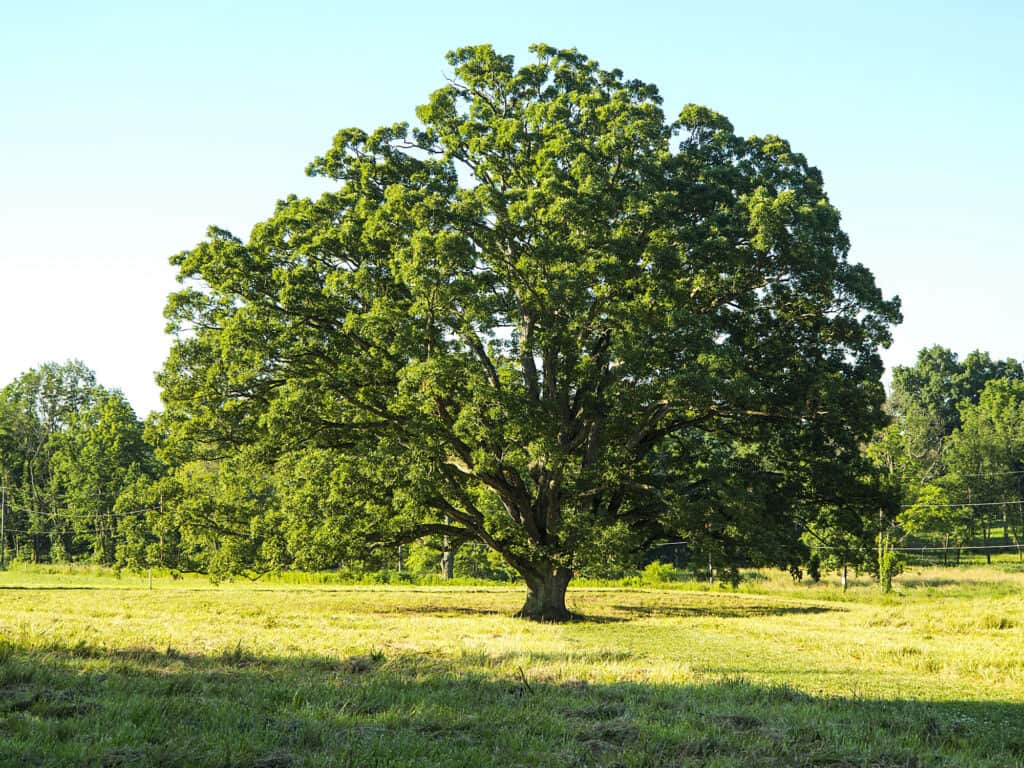
White oaks are hardwood trees that are native to Wisconsin.
©iStock.com/Cris Andrei
Summary of 11 Incredible Trees Native to Wisconsin
| Rank | Native Trees |
|---|---|
| 1 | Hemlock |
| 2 | Red Maple |
| 3 | Silver Maple |
| 4 | Serviceberry |
| 5 | Basswood |
| 6 | Yellow Birch |
| 7 | River Birch |
| 8 | Northern White Cedar |
| 9 | American Witchhazel |
| 10 | Shagbark Hickory |
| 11 | White Oak |
The photo featured at the top of this post is © ForestSeasons/Shutterstock.com
Sources
- , Available here: https://www.co.walworth.wi.us/DocumentCenter/View/579/Native-and-Non-Invasive-Trees-and-Shrubs-PDF
- , Available here: https://archive.org/details/ournativetreesa02keelgoog
- Columbia, Available here: https://www.ldeo.columbia.edu/~adk/oldlisteast/#spp
- US Department of Agriculture, Available here: https://www.nrs.fs.usda.gov/pubs/rb/rb_nrs23.pdf
- Wisconsin.gov, Available here: https://dnr.wisconsin.gov/topic/forestry
- Bonap, Available here: http://bonap.net/MapGallery/State/Amelanchier%20laevis.png
Thank you for reading! Have some feedback for us? Contact the AZ Animals editorial team.






